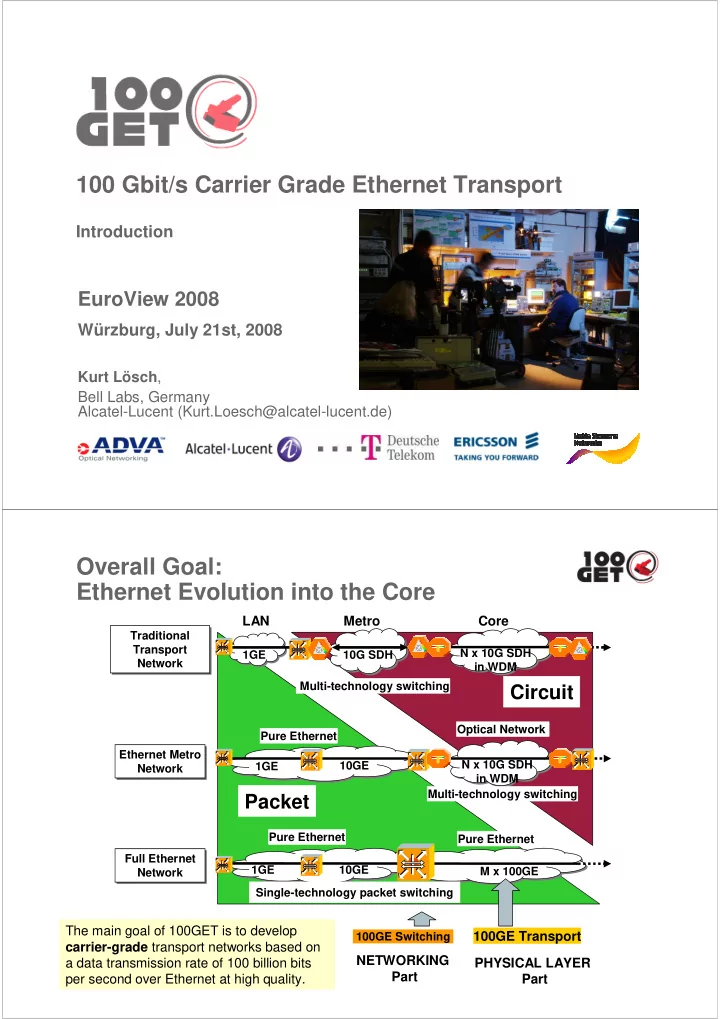

100 Gbit/s Carrier Grade Ethernet Transport Introduction EuroView 2008 Würzburg, July 21st, 2008 Kurt Lösch , Bell Labs, Germany Alcatel-Lucent (Kurt.Loesch@alcatel-lucent.de) Overall Goal: Ethernet Evolution into the Core LAN Metro Core Traditional Traditional Transport Transport N x 10G SDH 1GE 10G SDH Network Network in WDM Multi-technology switching Circuit Optical Network Pure Ethernet Ethernet Metro Ethernet Metro N x 10G SDH 10GE 1GE Network Network in WDM Multi-technology switching Packet Pure Ethernet Pure Ethernet Full Ethernet Full Ethernet 1GE 10GE M x 100GE Network Network Single-technology packet switching The main goal of 100GET is to develop 100GE Transport 100GE Switching carrier-grade transport networks based on NETWORKING a data transmission rate of 100 billion bits PHYSICAL LAYER Part per second over Ethernet at high quality. 2 Part
Project Structure 100GET 100GET Coordination Committee Coordination Committee Alcatel- ADVA Ericsson NSN Lucent 4 Project Clusters Universities -- Research institutes – + Small / medium enterprises 38 PY 144 PY 47 PY 106 PY Common testbed (DTAG) and technologies Cross-Project Activities Common testbed (DTAG) and technologies + Total Effort (3 years) 356 Person x Years Total Budget *: 63 M€* 4 Working Committees for technical exchange: 1: Network aspects and standardization ( lead: Gert Eilenberger, Alcatel-Lucent ) 2: 100GbE system technology and transmission (lead: Bernd Spinnler, NSN) 3: 100GbE technologies, comp. and measurements“ ( lead: Martin Schell, Fraunhofer–HHI) 4: Reference scenarios and test environment (lead: Ralf-Peter Braun, Deutsche Telekom) 3 * Funded in part by BMBF (Germany), MEFI (France), VINNOVA (Sweden), TEKES (Finland) 100GET Partners German Partners: • ADVA Optical Networking AG • Agilent Technologies R&D and Marketing GmbH & Co. KG • French Partners: Alcatel-Lucent Deutschland AG • • Alcatel THALES III-V Lab Atesio GmbH • • IntexyS SA CoreOptics • • University of Limoges Deutsche Telekom • Ericsson GmbH (EDD) • FhG - Heinrich Hertz Institut (HHI) • Swedish Partners: IHP GmbH • • Ericsson AB (EAB) JDSU Deutschland GmbH • Chalmers Univ. of Technology (CTH) • Konrad Zuse Zentrum für Informationstechik (ZIB) • Royal Institute of Technology (KTH) • Ludwig-Maximilians-Universität München (LMU) • Acreo AB • MICRAM Microelectronik GmbH • SP Devices (SPD) • NSN - Nokia Siemens Networks • Technical University Braunschweig • Technical University München Finnish Partners (contracts under negotation) • Technische Universität Dresden • NSN • TUHH (Technische Universität Hamburg-Harburg) • • Nethawk u2t Photonics AG • • Tellabs Uni Kiel - Christian Albrecht Univ. (CAU) • • VTT Universität Dortmund • • TKK, University of Helsinki Universität Stuttgart (IKR & INT) • Universität Würzburg • VPIsystems 4
Main Challenges in the Networking Domain • Carrier-grade and core-compatible Ethernet: – Multi-layer network management, operation, and interworking – Multi-domain operation and interworking • Ethernet/DWDM network architecture optimized for total cost of ownership – Combination of service/application-oriented L2 switching with cost-efficient L1 switching – Algorithms for NW migration and capacity planning (grooming, routing and resilience) – Multi-layer optimisation – Automated network management & control (“plug & play”) • Prototyping & lab trials; field trials • Joint standardisation effort of major European players – ITU-T SG 15, – IEEE 802.1/.3 Higher Speed Study Group � IEEE802.3ba 40Gb/s and 100Gb/s Ethernet Task Force since Dec.‘07 http://www.ieee802.org/3/ba/) 5 Physical Layer Challenge: „more bits in a given frequency channel“ 100 Gb/s on existing wavelength grids (100 or even 50 GHz spacing) ������������ ������������� ������������� �������������� �������������� ��������������� ��������������������� � � ����������������� ����� � � ���������� ����������������� � � Im{E x } Im{E x } Im{E x } ���� Re{E x } Re{E x } Re{E x } Im{E y } New optical measurement Re{E y } systems needed e.g. constellation analysis � Horizontal activity E x … Optical field, x-polarization E y … Optical field, y-polarization (JDSU) 6
Main Challenges for Components and Electronics • Very high bandwidth devices for On/Off Keying 3dB corner frequency = 70 GHz; • Integration of complex transmitter and receiver optics for coherent polarisation multiplexing systems • High speed Analog/Digital Converters and Digital/Analog Converters e.g. 4 channels in one device: sampling rate 28 GSample/s Total Throughput resolution 4 bit/Sample = 448 Gb/s • Packaging and subsystem assembly 7 8
Recommend
More recommend